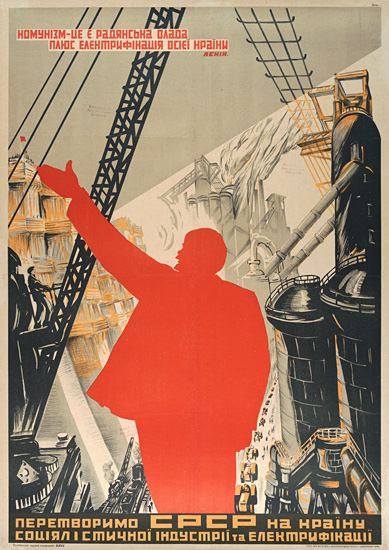
Another aspect of the culture that also exemplified High Stalinism were songs. These songs were often joyful–going along with the theme optimism of the time. A song that demonstrated the common themes of happiness, exploration, and individual excellence of the era came from a comedic film Happy-Go-Lucky Guys (1934). The song is called “March of the Happy-Go-Lucky Guys”:
Merry singing fills the heart with joy,/it will never let you be sad./The country side and villages love/singing,/And big cities love cities too.
Refrain:
A song helps us building and living,/Like a friend, it calls and leads us forth./And whoever goes through life singing,/Will never ever fall behind./And whoever goes through life singing,/Will never ever fall behind.
Stride forward, clan of Young/Communists,/Sing and joke, and make smiles bloom./We are taming space and time,/We are the young masters of the earth
Refrain.
We’ll grasp, discover, and attain it all,/The cold North Pole and the clear blue/sky,/When our country commands that we/be heroes,/Then anyone can become a hero.
Refrain.
We can sing and laugh like children,/Amid our constant struggle and toil,/But that’s how we were born into the/world,/Nowhere and never to relent!
Refrain.
If our enemy decides to start a battle/To take our living joy away from us,/Then we’ll strike up our songs of battle,/And leap to defend our motherland.
Refrain.
This song perfectly summarizes the time period of High Stalinism making multiple references to specific aspects of Russian culture that characterize the time period. Joy and happiness are referenced multiple times throughout the song. For example, in the first stanza the song begins with the lyrics, “Merry singing fills the heart with joy” which exemplifies the happiness and joy that the time period exuded. Adjectives like “joy”, “love”, “smiles”, and “sing” that all connote happiness are used throughout the song. Another example of High Stalinism characteristics in the song include the references to exploration which was also an aspect of the era. The song goes: “We’ll grasp, discover, and attain it all/The cold North Pole and the clear blue/sky”. This mention to the North Pole makes reference to the exploration attempts during the era that helped define High Stalinism. The last characteristic exemplified in the song is that of making heroes out of individuals who excel. During this era, the celebration of “outstanding individuals” was common place. “When our country commands that we be heroes, Then anyone can become a hero,” goes the song and it makes reference to how if an individual is asked to excel then they can become heroes for their country.
This song I believe truly epitomizes High Stalinism and touches on multiple different aspects of Russian culture at that time.
Sources:
Flying High (Stalinism)
Early Soviet Exploration (1920s-1930s).” : Beaufort Gyre Exploration Project. N.p., n.d. Web. 10 Oct. 2015.
Geldern, James Von, and Richard Stites. Mass Culture in Soviet Russia: Tales, Poems, Songs, Movies, Plays, and Folklore, 1917-1953. Bloomington: Indiana UP, 1995. Print.
Nelson, Amy, Dr. “Soviet Union Culture–Collectivization and Industrialization.” Blacksburg. Lecture.
“Views and Re-Views: Soviet Political Posters and Cartoons | View By Artist.” Views and Re-Views: Soviet Political Posters and Cartoons | View By Artist. N.p., n.d. Web. 10 Oct. 2015.
I like how you focus in on the return of the hero and how celebrating individual achievement becomes a hallmark of socialist culture. The source you found on Soviet Polar exploration looks really interesting. Thanks!
This was a great post! I thought the way you tied the song into your analysis of High Stalinism helped give context to just how deep and wide the era was. This was not a period that effected one one or two aspects of the peoples’ lives. Everything from the art, mindset, physique and music was effected. This post does a good job bringing that to light and just opening up the idea that the 1930s were a truly dynamic and culturally diverse era within the USSR.